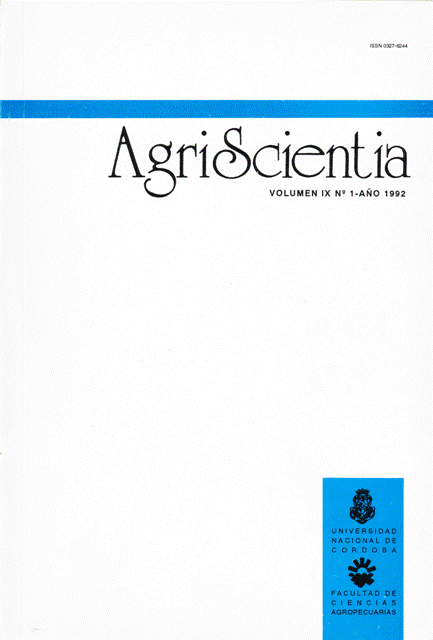Plant morphogenesis. A mini review
Main Article Content
Abstract
The term Morphology, coined by Goethe (1790), refers to the oldest branch of botany, devoted to the analysis of shapes regardless of the causes which generate them. Sachs (1880), following the ideas of Bacon (1561-1626), applied the law of causality to descriptive morphology, and thus, Morphogenesis was born. Phytomorphogenesis has long been part of physiology, biochemistry, biophysics, and molecular biology. It is the science that deals with the causes and the origin of shapes. In a plant, shapes develop in gradual stages of perfectly ordered structural changes, which result in organization (epigenesis). The changes in design are programmed in the genome, but their expression is controlled by precise endogenous mechanisms and environmental signals. From the phenomenological point of view, axiality, polarity, differentiation, and correlations are all operative. Physiological development is concomitant with morphogenesis, and both result in the climax process of flowering. Correlation plays a fundamental role, as each cell receives information from all parts of the organism by means of chemical (hormones, nutrients) or physical signals (light, gravity). The differentiation of a new organ or tissue implies the expression of specific genes induced by the interaction of hormones, nutrients, or physical signals.
Article Details

This work is licensed under a Creative Commons Attribution-ShareAlike 4.0 International License.
How to Cite
References
Aristóteles. Metafísica. Ed. Sarpe, Madrid, 1985. 403 p.
Ashby, G. (1950). Studies in the morphogenesis of the leaves, VI. Some effects of length day upon the leaf shape in Ipomoea caerulea. New Phytologist, 49, 375-387.
Bacon, F. Novum organum. Ed. Sarpe, Madrid, 1984. 302 p.
Bernier, G. The control of Plant Evocation and Morphogenesis. In Ann. Rev. Plant Phys., 39 (1988), 175. Palo Alto, California, EEUU.
Bonner, J. The Molecular Biology of Development. Clarendon Press, Oxford, 1965. 155 p.
Cholodny, N. G. (1939). Fitogormony. Kiev: Iza. Akad. Nauk. URSS.
Gasser, Ch. S. Molecular studies on the differentiation of Floral Organs. In Ann. Rev. Plant Phys., 42 (1991), 621. Palo Alto, California.
Goethe, J. W. (1790). Versuch die Metamorphose der Pflanzen zu erklären. Gotha.
Goebel, K. (1880). Beiträge zur Morphologie und Physiologie des Pflanzen. Bot. Ztg., 38, 801-815.
Goebel, K. (1900). Organography of Plants, Part I, General Organography. Oxford: At the Clarendon Press. 270 p.
Gollin, D. J., et al. (1984). Biol. Cell, 51, 275-280.
Gray, P. The Encyclopedia of the Biological Sciences. Reinhold Publ. Co., New York, 1960.
Grierson, D., & Covey, S. N. (1991). Biología Molecular de las Plantas. Ed. Acribia, S. A., Zaragoza, España. 243 p.
Keller, J. M., & Hersky, H. P. (1989). Structure and Regulation of light-inducible Genes: Phytochrome, Properties of a photoreceptor that regulates its own expression. In Cell Culture and Somatic Cell Genetics of Plants. Ed. I. K. Vasil. Vol. 6. Molecular Biology of Plant Nuclear Genes. Ed. J. Schell & I. K. Vasil. Academic Press, New York.
Kendrick, R. E., & Kronenberg, G. H. M. (1986). Photomorphogenesis in Plants. Martimus Nijhoff Publ., Boston. 580 p.
Meense, A. D. J. (1966). Fundamentals of Phytomorphology. The Roland Press Co., New York. 231 p.
Mohr, H. Principles in plant morphogenesis. In Axioms and Principles of Plant Construction (R. Satler, Ed.), pp. 93-111. Martimus Nijhoff, La Haya.
Montaldi, E. R. Factores trágicos en la morfogénesis vegetal. In Recientes Avances en Biología (R. H. Mejía & J. A. Mogullevsky, Eds.). Imprenta Bona, Buenos Aires, 1971, p. 265.
Sach, J. (1880). Stoff und Form des Pflanzenorgane. Arb. Bot. Inst. Wurzburg, 11, 452.
Sach, J. von (1887). Lectures on the Physiology of Plants. Oxford: At the Clarendon Press. 836 p.
Salisbury, F. B., & Parke, R. V. Vascular Plants: Form and Function. Wadsworth Publ. Co., Inc., Belmont, California, 1965. 184 p.
Sánchez, R. Fotomorfogénesis vegetal. In Recientes Avances en Biología (R. H. Mejía & J. A. Mogullevsky, Eds.). Imprenta Bona, Buenos Aires, 1971, p. 268.
Smith, A. G., et al. (1989). Structure and Regulation of Organ- and Tissue-specific Genes: Regulated Expression of Flower-specific Genes. In Cell Culture and Somatic Cell Genetics of Plants. Ed. I. K. Vasil. Vol. 6. Molecular Biology of Plant Nuclear Genes. Ed. J. Schell & I. K. Vasil. Academic Press, New York.
Smith, A. G., Gasser, C. S., Budelier-Sachs, K. A., Hinchee, M. A., McCormick, Sheila, Horsch, R. B., & Fraley, R. T. (1989). Structure and Regulation of Organ- and Tissue-Specific Genes: Regulated Expression and Flower-Specific Genes. In Cell Culture and Somatic Cell Genetics of Plants. Vol. 6. Molecular Biology of Plant Nuclear Genes (J. Schell & I. K. Vasil, Eds.), pp. 175-214.
Steeves, T. A., & Sussex, I. M. (1972). Patterns In Plant Development. Prentice-Hall, Inc., New Jersey, EEUU. 302 p.
Steward, F. C. Growth and Organization in Plants. Addison-Wesley Publ. Co., Reading, Massachusetts, 1968. 564 p.
Torrey, J. G. Development in Flowering Plants. MacMillan Co., New York, 1967. 184 p.
Tran Than Van, K., et al. (1985). Nature, 314, 615-617.
Went, F. W., & Thimann, K. V. (1937). Phytohormones. The MacMillan Co., 294 p.





